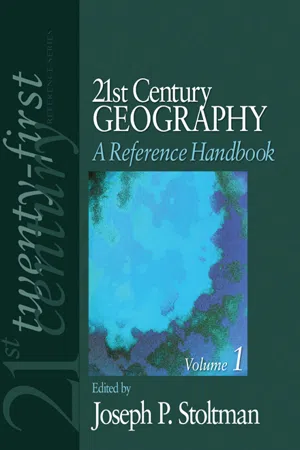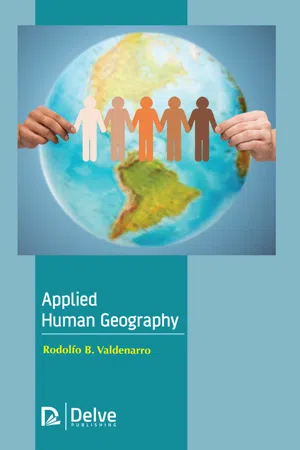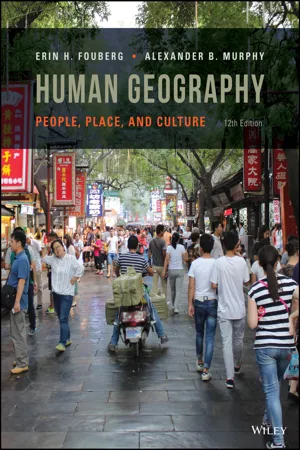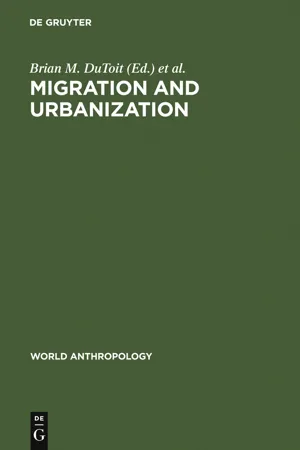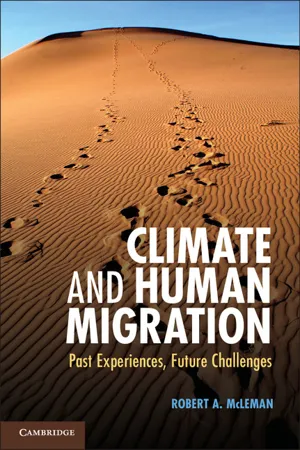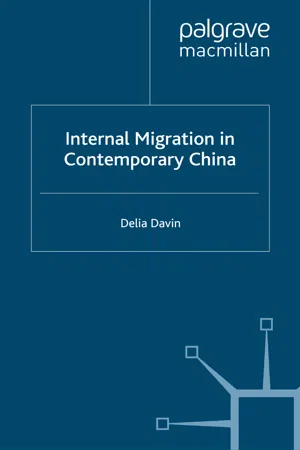Geography
Voluntary Migration
Voluntary migration refers to the movement of people from one place to another by their own choice, often in search of better opportunities, improved living conditions, or personal reasons. This type of migration is driven by individual decision-making and is not forced by external factors such as conflict or persecution. It is a key aspect of population geography and has significant social and economic implications.
Written by Perlego with AI-assistance
Related key terms
1 of 5
6 Key excerpts on "Voluntary Migration"
- eBook - PDF
- Joseph P. Stoltman(Author)
- 2011(Publication Date)
- SAGE Publications, Inc(Publisher)
Migration involves people leaving a place (origin) and arriving at a new place (destination) under varying circum- stances. Migration is not pursued in isolation because the decision to migrate is linked to numerous push and pull factors. If City A has 30% unemployment and City B has a 5% or lower unemployment rate, it seems apparent that the economic hardship would act as the push factor to encourage people to leave City A and the opportunity (low unemployment rate) would act as the factor pulling people toward City B. There are intervening obstacles, which may impede migration, and that discussion is presented later in the chapter. Wherever there are movements of people, there are consequent demographic, social, and economic changes with spatial implications. Geographers study the spatial nature of movement and seek to derive the motives that people have for moving. The geographic contexts for 231 232 • HUMAN GEOGRAPHY migration occurs in multiple forms, such as people fleeing regions experiencing military conflicts, land-poor people settling new lands that are available for agriculture, or the mass migrations of Europeans moving to the Americas during times of religious, economic, and political repres- sion. These movements represent humans' quest for new beginnings and illustrate the migration phenomenon and restructuring of populated places in the world. Geography as a spatial discipline synthesizes and analyzes migration at different scales in the context of a place of origin and a place of destination. What Is Migration? What is migration? It can be defined spatially, based on where and how long individuals change their residential address domestically or internationally. Is the move perma- nent or semipermanent? Is it migration if a person moves from downtown Los Angeles to Hollywood? How about Mr. - eBook - PDF
- Rodolfo B. Valdenarro(Author)
- 2019(Publication Date)
- Delve Publishing(Publisher)
4. Chain migration Relocation of families at various phases of the existence cycle starting with one area then onto the next, who consequently carry individuals from their Migration: The Human Movement to Other Places 189 home area to this new place. In principle, a chain of individuals always moves from spot to put, upheld by the individuals who relocated before them. 9.2.3. By Decision-Making Approach In view of characterizing movement as intentional or automatic, given certain sociopolitical factors (for example the dread of abuse credited to race, religion, political alliance, nationality or relationship to social gatherings; departure from war; struggle including arms; common war; characteristic or man-made calamities; starvation) or formative variables (for example generous foundation ventures, including airplane terminal, street, dam or port development; the regulatory leeway of urban undertakings; mining and deforestation; the formation of protection parks/holds and other biosphere related activities, among others): 1. Voluntary Migration In light of an individual’s through and through freedom, activity and want to live in a superior spot and to improve their budgetary status, among different elements. 2. InVoluntary Migration In light of an individual’s being constrained out of their home because of certain negative natural and political circumstances. This can be further sub classified as: • Reluctant/impelled/imposed migration – When an individual is placed in a circumstance that empowers migration or development outside their place of habitation. • Forced migration – When an individual can’t return home (exile), or experiences a lawful method to qualify as an outcast in the host nation (asylee), or is driven away from their home because of a contention or improvement however does not cross any limits (inside dislodged individual [IDP]). Applied Human Geography 190 Figure 9.2: Representation of Types of Migration. - eBook - PDF
Human Geography
People, Place, and Culture
- Erin H. Fouberg, Alexander B. Murphy(Authors)
- 2020(Publication Date)
- Wiley(Publisher)
Most are migrants who reported average salaries of less than $150 a month. This chapter explores why people migrate, whether by force or voluntarily. We discuss where people migrate, both within countries and across country borders, and how governments impact migration. CHAPTER OUTLINE 3.1 Explain migration as a type of movement. • Cyclic Movement • Migration 3.2 Explain Historic and Modern Forced Migration. • Historic Forced Migration • Modern Slavery and Human Trafficking 3.3 Explain the Theories of Migration and Understand the Motivations for Migration. • Laws of Migration and the Gravity Model • Push and Pull Factors 3.4 Identify why refugees are a distinct group of migrants and describe where most refugees migrate. • Distribution of Refugees • Areas of Dislocation 3.5 Determine how government policies impact migration. • Waves of Immigration in the United States • Legal Restrictions Photo by A.B. Murphy. © 2020 John Wiley & Sons, Inc. FIGURE 3.1 Mumbai, India. A view from the top of a high-rise in the central city, looking at one of the slums found tucked between buildings throughout the city. The Census of India reports that more than 50 percent of the Mumbai’s residents live in slums. 3.1 Explain Migration as a Type of Movement 63 Migration is a type of movement that changes both the places migrants leave and the places they go. The movement of peo- ple along paths of migration creates connections and networks among places. Migration changes how people see themselves and others. It also increases spatial interaction and speeds the diffusion of ideas and innovations among places connected through migration. Geographers identify two basic types of movement. Leav- ing home for a defined amount of time and returning home is called cyclic movement. Migration changes the location of home and has a degree of permanence not found in cyclic movement. Migration is movement from a home location to a new place with an intent to stay in the new place permanently. - eBook - PDF
Migration and Urbanization
Models and Adaptive Strategies
- Brian M. DuToit, Helen I. Safa, Brian M. DuToit, Helen I. Safa(Authors)
- 2011(Publication Date)
- De Gruyter Mouton(Publisher)
Introduction Migration and Population Mobility BRIAN M. DU TOIT One of the distinguishing characteristics of Homo sapiens is his tendency to migrate, and the frequency and distance of these movements mark him alone. This feature is due in part to the cultural adaptability which allows man to adjust to major ecological changes by employing his mental abilities and technological skills. These same tendencies and abilities may result in the mobility of a total social group, the migration of single families, or of single individuals. A combination of his animal tendency for self-preservation and his culturally defined tendency for self-improve-ment has resulted in the distribution of Homo sapiens to every part of the earth. It has also resulted in population concentrations where man's technological know-how has produced complex machines, mechanical as well as sociopolitical. Each of these situations has its own attractions and its own adaptive requirements. 1. The concept of MIGRATION, as will be discussed below, may apply to various forms of population movement. It may also imply a smaller or larger degree of volition on the part of the migrant. While not attempting here any kind of a compendium of migration, it would be useful to point to some of the major forms human migration takes. First and foremost we should distinguish between FORCED and Voluntary Migration. In the case of the former, the person who is migrat-ing has either no decision or hardly any say about the decision to migrate. We may distinguish between cases where persons are physically removed from one place to another (as happened during conditions of slavery, in times of war, and in some of the African relocation programs in South Africa) and cases with a degree of volition, even if it implies the choice - eBook - PDF
Climate and Human Migration
Past Experiences, Future Challenges
- Robert A. McLeman(Author)
- 2013(Publication Date)
- Cambridge University Press(Publisher)
For migrants travelling long distances to settle in new and unfamiliar places, migration may be a long and arduous process, with integration into the destination population never completed within the migrant’s own lifetime, but continued by subsequent generations. The migration process as experienced by the individual does not exist in a vacuum; it is nested within larger sets of dynamic and interconnected cultural, economic, envi- ronmental, political, and social processes that shape human behavior more gener- ally. A decision to migrate today may be the product of any number of antecedent 2 Why People Migrate 2.2 Basic Assumptions of Modern Migration Research and Their Origins 17 conditions and events. And, once acted upon, the decision to migrate generates new sets of risks and opportunities not only for the migrant, but for his or her social net- work, and for the sending and receiving communities as well. Migration is more than simply a movement across physical space; it is a change in the trajectory of an indi- vidual and those connected to that individual through social space. The aim of this chapter is to provide the nonspecialist a clear overview of current scholarly understanding of the migration process and to introduce a set of basic the- ories, concepts, and terms that: Have been used in a wide variety of settings to explain and interpret how migration deci- • sions are made and the factors that shape migration behavior generally; Can be used to describe and analyze in a systematic fashion known examples of migration • related to droughts, floods, extreme weather events, and other climate-related phenomena; and Will be combined in • Chapter 3 with scholarship that considers human vulnerability and adaptation to climatic variability and change in order to create a conceptual framework that shows the interactions between climate and migration within the context of an adaptive human-environment system. - eBook - PDF
- D. Davin(Author)
- 1998(Publication Date)
- Palgrave Macmillan(Publisher)
4 Why People Migrate The very first year we farmed our contract land the crops failed. The grain we got was next to nothing - never mind paying our taxes, it wasn't even enough to keep belly from backbone. That's why there's so many of us trying to make a living in the city this year. Some of the men pop corn and some of them are in construc- tion teams putting up buildings for the government. The women have gone to the cities as maids. None of us arc beggars, at least none from our village .... We leave the village to work and make money .... We started working when we got to Hefei. We worked there for a week and then made enough for our fares to Beijing. Making money in the big cities is easy. (Child migrant from Anhui interviewed in Beijing in 1984. Zhang and Sang 1986: 3-7) Individuals migrate because they think that they can improve their own lives or those of their families by doing so. Economic migration is triggered by the knowledge (or belief) that better economic opportu- nities exist in some other place. It follows that where regional and local economic inequality is considerable, people are like ly to migrate if it is possible for them to do so. Factors such as poverty, lack of econ- omic opportunity, land shortage and low living standards at home function as push factors, while prosperity, opportunity, available employment and higher living standards in the place of destination are pull factors. The individual's decision to migrate involves a process of weighing up potential costs and benefits. 1 Migrants have to consid er general factors such as the cost of travel and accommodation, the chances of finding work and the prevailing wage rates in the destina- tion area compared with those in the home area. They will also be swayed by individual factors such as contacts with relatives or friends in the destination areas, or the potential effect of their absence on the household left behind.
Index pages curate the most relevant extracts from our library of academic textbooks. They’ve been created using an in-house natural language model (NLM), each adding context and meaning to key research topics.
